Optimal Sizing of Vanadium Redox Flow Battery Systems for Residential Applications Based on Battery Electrochemical Characteristics
Abstract
:1. Introduction
2. Computation of VRB Costs
2.1. Capital Cost
2.2. Maintenance Cost
2.3. Overall Cost
3. VRB Charging and Discharging Efficiencies
4. Australian Time-Of-Use Market Policy
5. Optimal Sizing of VRB
6. Conclusions
Acknowledgments
Author Contributions
Conflicts of Interest
Nomenclature
| Nominal power of VRB in kW | |
| Nominal current of VRB in amperes | |
| Nominal capacity of VRB in hours | |
| Current density of VRB in amperes/cm | |
| Maximum power rating of each VRB stack in kW (chosen as 10 kW in this paper) | |
| Estimated power loss caused by pumping in kW | |
| Estimated power loss caused by shunt current in kW | |
| Estimated total extra power loss in kW | |
| Total number of stacks in VRB | |
| Nominal stack voltage in volts | |
| Total number of cells in VRB | |
| Cell discharge voltage at 50% SOC in volts | |
| Cell resistance in Ohm·cm | |
| Voltage efficiency at nominal power | |
| Volume of electrolyte in litres | |
| Cost of membrane in dollars | |
| Cost of graphite in dollars | |
| Cost of endplate in dollars | |
| Cost of flow frame in dollars | |
| Cost of assembling in dollars | |
| Cost of each stack in dollars | |
| Cost of electrolyte in dollars | |
| Cost of tank in dollars | |
| Cost of pump in dollars | |
| Total cost of VRB in dollars | |
| Cost of inverter in dollars | |
| Cost of parts replacement in dollars | |
| Cost of maintenance in dollars | |
| Overall cost of VRB system in dollars | |
| Life span of VRB in years | |
| Lifespan of membrane in years | |
| Area of electrode in cm | |
| Area of membrane in cm | |
| Area of graphite in cm |
Greek Symbols
| Electrolyte weight (kg) per kWh at 100% utilization rate | |
| Moles per kWh at 100% utilization rate | |
| Electrolyte utilization rate | |
| Vanadium concentration in moles/litre | |
| Rate of membrane cost in dollars/m | |
| Rate of graphite cost in dollars/m | |
| Rate of endplate cost in dollars/each | |
| Rate of electrode fabrication cost in dollars/each | |
| Rate of assembling cost in dollars/stack | |
| Rate of flow frame fabrication cost in dollars/each | |
| Rate of vanadium cost in dollars/kg | |
| Rate of acid cost in dollars/litre | |
| Rate of tank cost in dollars/kWh | |
| Rate of pump cost in dollars/kW | |
| Rate of inverter cost in dollars/kW | |
| Rate of annual maintenance cost in dollars/year | |
| Coefficient of mark-up | |
| Coefficient of replacement labour cost/kW |
References
- Smith, J.; Sunderman, W.; Dugan, R.; Seal, B. Smart inverter volt/var control functions for high penetration of PV on distribution systems. In Proceedings of the 2011 IEEE/PES Power Systems Conference and Exposition (PSCE), Phoenix, AZ, USA, 20–23 March 2011; pp. 1–6.
- Eftekharnejad, S.; Vittal, V.; Heydt, G.T.; Keel, B.; Loehr, J. Impact of increased penetration of photovoltaic generation on power systems. IEEE Trans. Power Syst. 2013, 28, 893–901. [Google Scholar] [CrossRef]
- Wang, Y.; Zhang, P.; Li, W.; Xiao, W.; Abdollahi, A. Online overvoltage prevention control of photovoltaic generators in microgrids. IEEE Trans. Smart Grid 2012, 3, 2071–2078. [Google Scholar] [CrossRef]
- Tonkoski, R.; Turcotte, D.; El-Fouly, T.H. Impact of high PV penetration on voltage profiles in residential neighborhoods. IEEE Trans. Sustain. Energy 2012, 3, 518–527. [Google Scholar] [CrossRef]
- Alam, M.; Muttaqi, K.; Sutanto, D. Mitigation of rooftop solar PV impacts and evening peak support by managing available capacity of distributed energy storage systems. IEEE Trans. Power Syst. 2013, 28, 3874–3884. [Google Scholar] [CrossRef]
- Shi, H.; Zhuo, F.; Yi, H.; Wang, F.; Zhang, D.; Geng, Z. A novel real-time voltage and frequency compensation strategy for photovoltaic-based microgrid. IEEE Trans. Ind. Electron. 2015, 62, 3545–3556. [Google Scholar] [CrossRef]
- Mountain, B. Electricity Prices in Australia: An International Comparison; Carbonmarkets: Melbourne, Austrilia, March 2012. [Google Scholar]
- De la Hoz, J.; Martín, H.; Miret, J.; Castilla, M.; Guzman, R. Evaluating the 2014 retroactive regulatory framework applied to the grid connected PV systems in Spain. Appl. Energy 2016, 170, 329–344. [Google Scholar] [CrossRef]
- Faruqui, A.; Hledik, R.; Palmer, J. Time-Varying and Dynamic Rate Design; Regulatory Assistance Project: Montpelier, VT, USA, 2012. [Google Scholar]
- Matters, E. Feed-In Tariff for Grid-Connected Solar Power Systems. 2011. Available online: http://www.energymatters.com.au/rebates-incentives/feedintariff/ (accessed on 20 August 2016).
- Matters, E. Battery Storage And Solar Feed In Tariffs—State of Play. 2015. Available online: http://www.energymatters.com.au/renewable-news/solar-fit-batteries-em5074/ (accessed on 20 August 2016).
- Divya, K.; Østergaard, J. Battery energy storage technology for power systems—An overview. Electr. Power Syst. Res. 2009, 79, 511–520. [Google Scholar] [CrossRef]
- Qiu, X.; Nguyen, T.A.; Guggenberger, J.D.; Crow, M.L.; Elmore, A.C. A field validated model of a vanadium redox flow battery for microgrids. IEEE Trans. Smart Grid 2014, 5, 1592–1601. [Google Scholar] [CrossRef]
- Li, L.; Kim, S.; Wang, W.; Vijayakumar, M.; Nie, Z.; Chen, B.; Zhang, J.; Xia, G.; Hu, J.; Graff, G.; et al. A stable vanadium redox-flow battery with high energy density for large-scale energy storage. Adv. Energy Mater. 2011, 1, 394–400. [Google Scholar] [CrossRef]
- Borowy, B.S.; Salameh, Z.M. Methodology for optimally sizing the combination of a battery bank and PV array in a wind/PV hybrid system. IEEE Trans. Energy Convers. 1996, 11, 367–375. [Google Scholar] [CrossRef]
- Elhadidy, M.; Shaahid, S. Optimal sizing of battery storage for hybrid (wind+ diesel) power systems. Renew. Energy 1999, 18, 77–86. [Google Scholar] [CrossRef]
- Arun, P.; Banerjee, R.; Bandyopadhyay, S. Optimum sizing of battery-integrated diesel generator for remote electrification through design-space approach. Energy 2008, 33, 1155–1168. [Google Scholar] [CrossRef]
- Nguyen, T.A.; Qiu, X.; Guggenberger, J.D., II; Crow, M.L.; Elmore, A.C. Performance characterization for photovoltaic-vanadium redox battery microgrid systems. IEEE Trans. Sustain. Energy 2014, 5, 1379–1388. [Google Scholar] [CrossRef]
- Nguyen, T.A.; Crow, M.L.; Elmore, A.C. Optimal sizing of a Vanadium Redox battery system for microgrid systems. IEEE Trans. Sustain. Energy 2015, 6, 729–737. [Google Scholar] [CrossRef]
- Eckroad, S. Vanadium Redox Flow Batteries: An In-Depth Analysis; Electric Power Research Institute: Palo Alto, CA, USA, 2007. [Google Scholar]
- Tant, J.; Geth, F.; Six, D.; Tant, P.; Driesen, J. Multiobjective battery storage to improve PV integration in residential distribution grids. IEEE Trans. Sustain. Energy 2013, 4, 182–191. [Google Scholar] [CrossRef]
- Ahlert, K.H. Economics of Distributed Storage Systems; Karlsruher Institut Für Technologie: Karlsruhe, Germany, 2010. [Google Scholar]
- Li, Y.; Skyllas-Kazacos, M.; Bao, J. A dynamic plug flow reactor model for a vanadium redox flow battery cell. J. Power Sources 2016, 311, 57–67. [Google Scholar] [CrossRef]
- Burke, K.B. The reliability of distributed solar in critical peak demand: A capital value assessment. Renew. Energy 2014, 68, 103–110. [Google Scholar] [CrossRef]
- Fan, S.; Hyndman, R.J. Short-term load forecasting based on a semi-parametric additive model. IEEE Trans. Power Syst. 2012, 27, 134–141. [Google Scholar] [CrossRef]
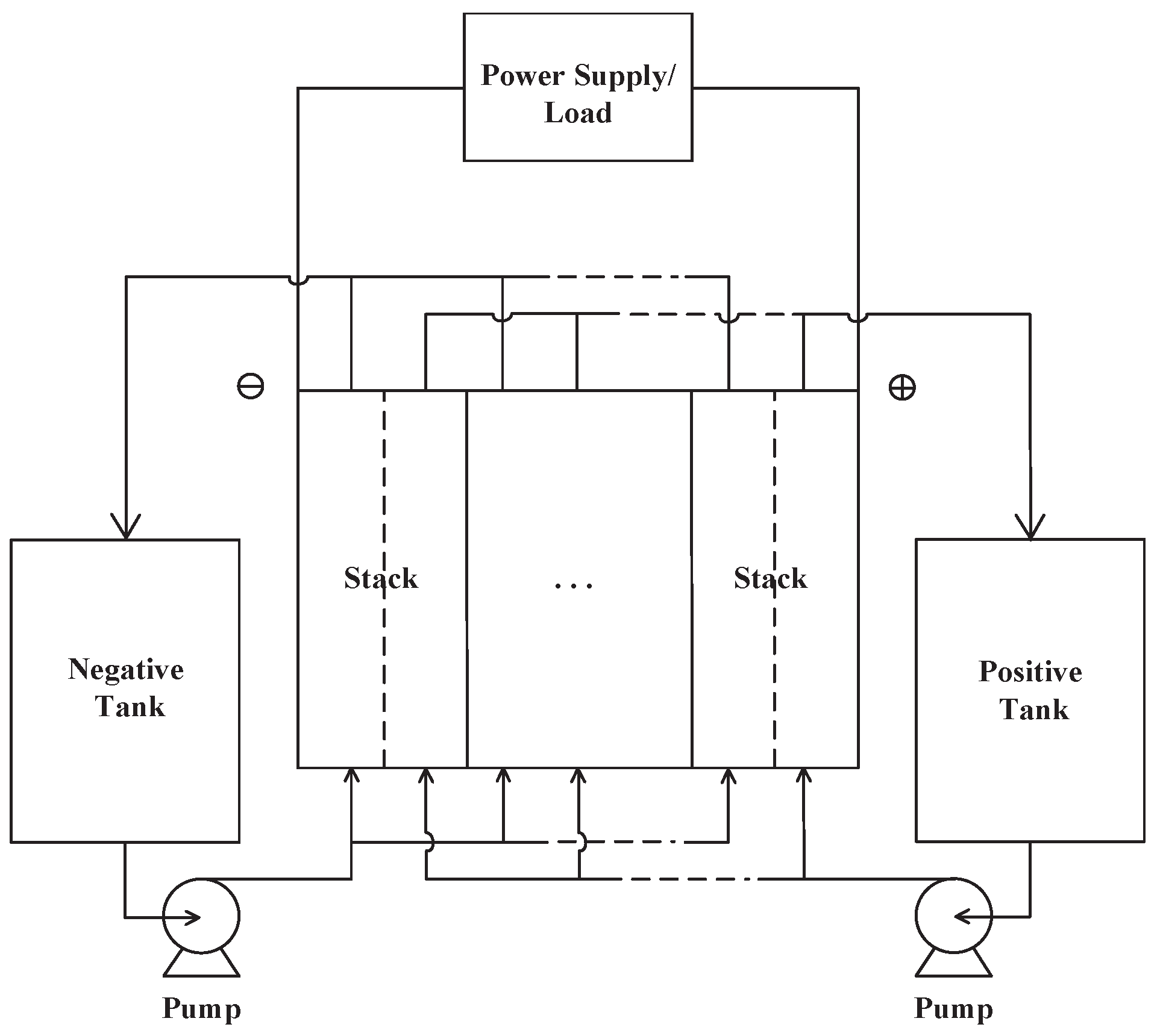
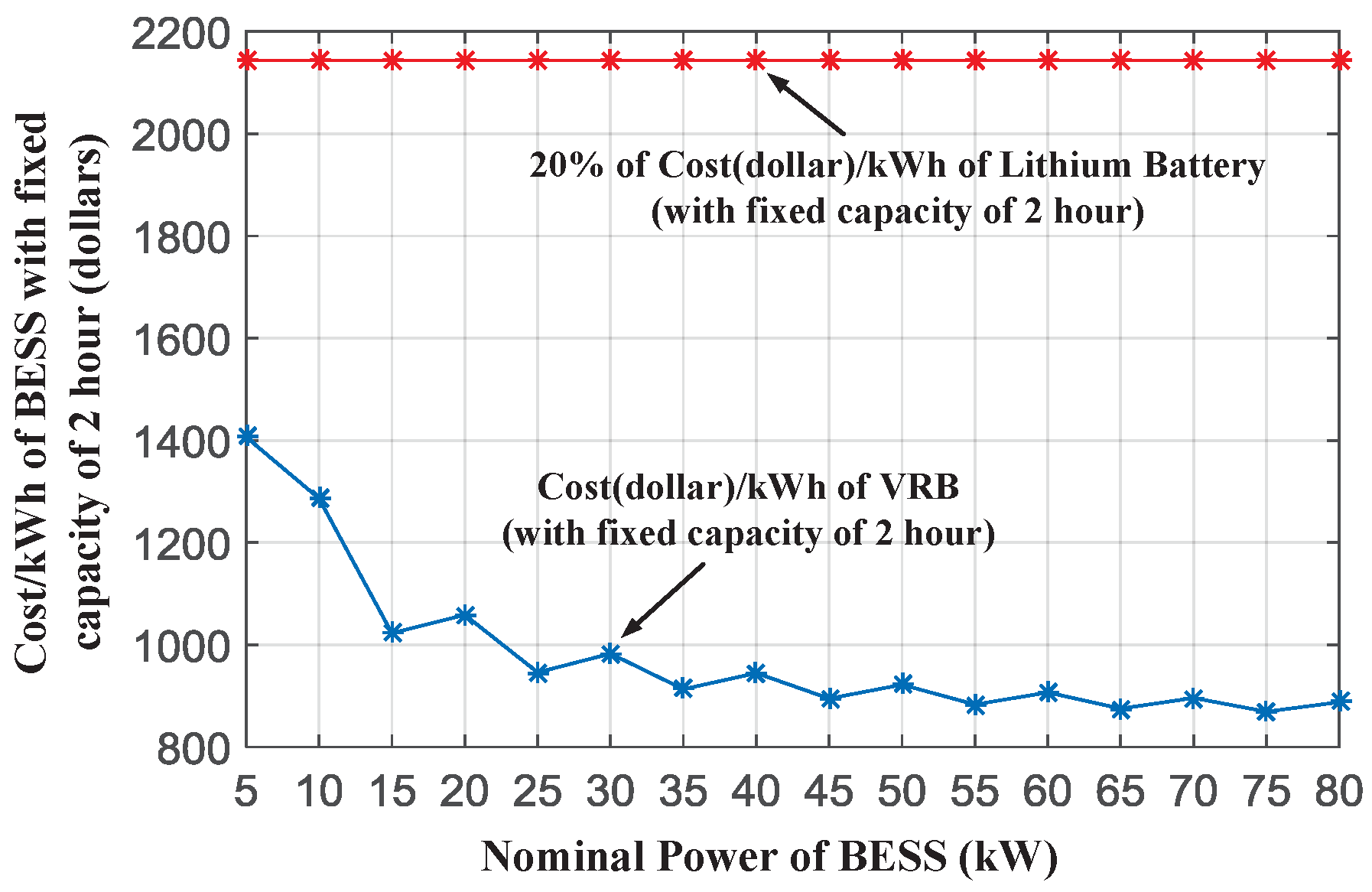
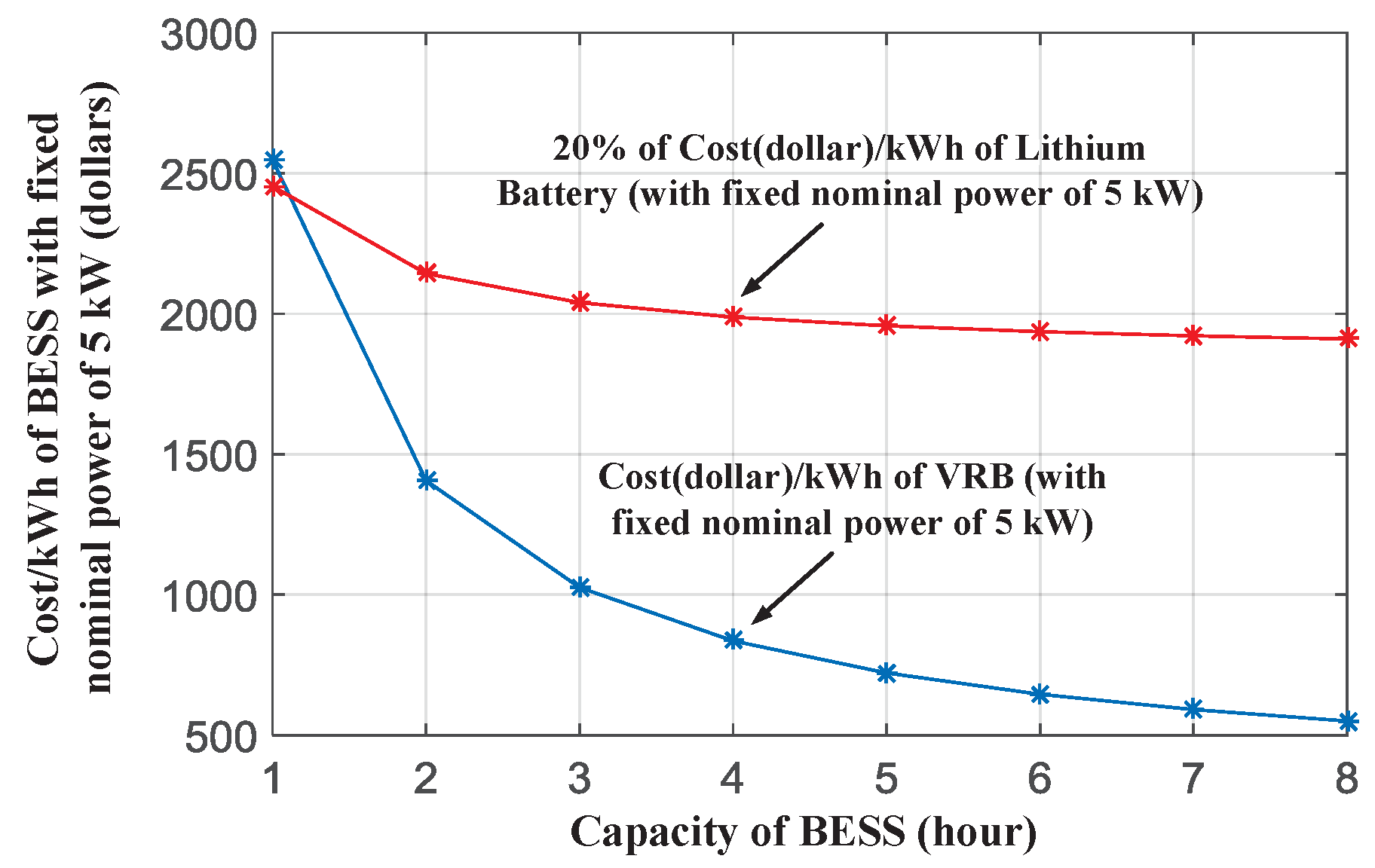
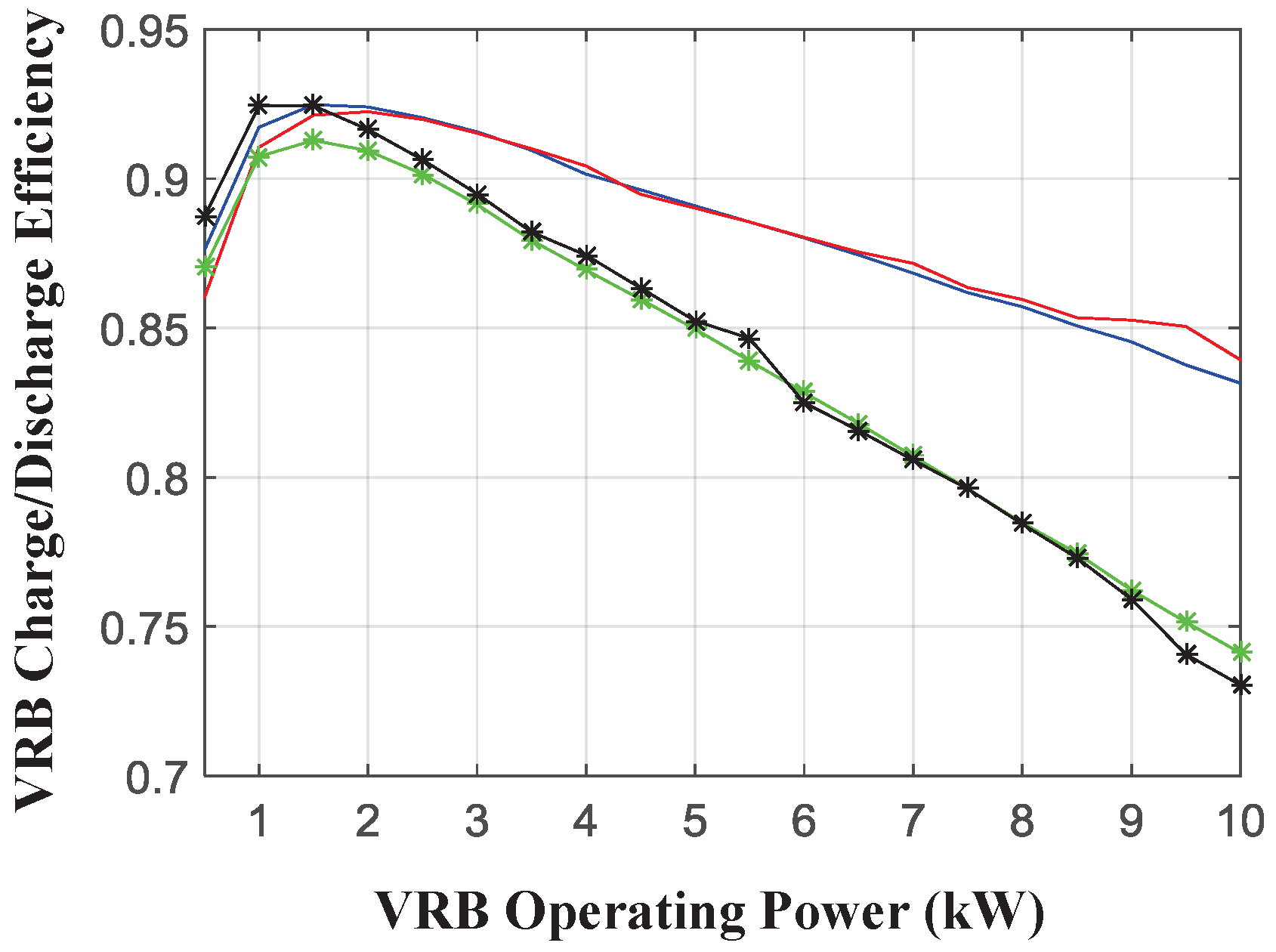
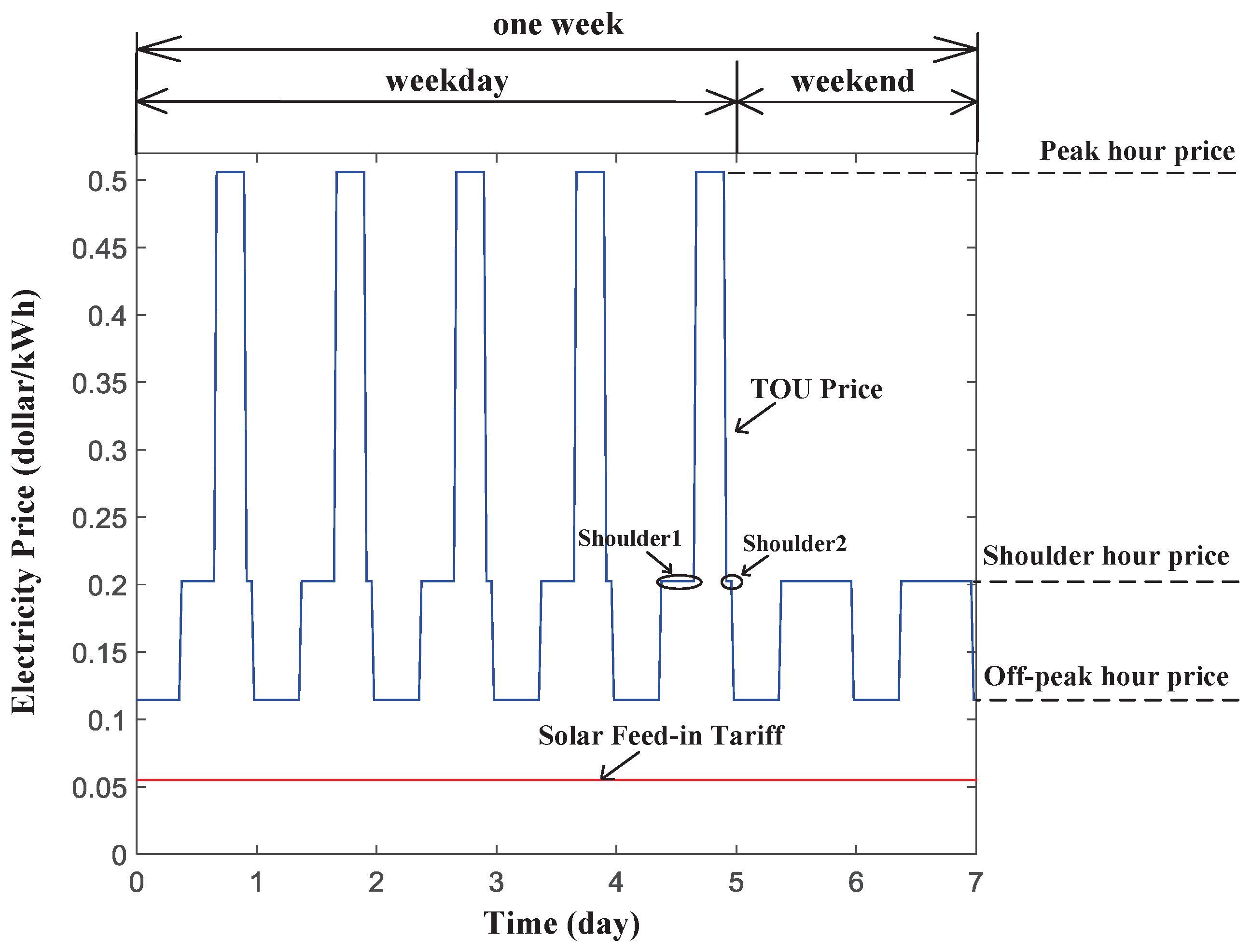
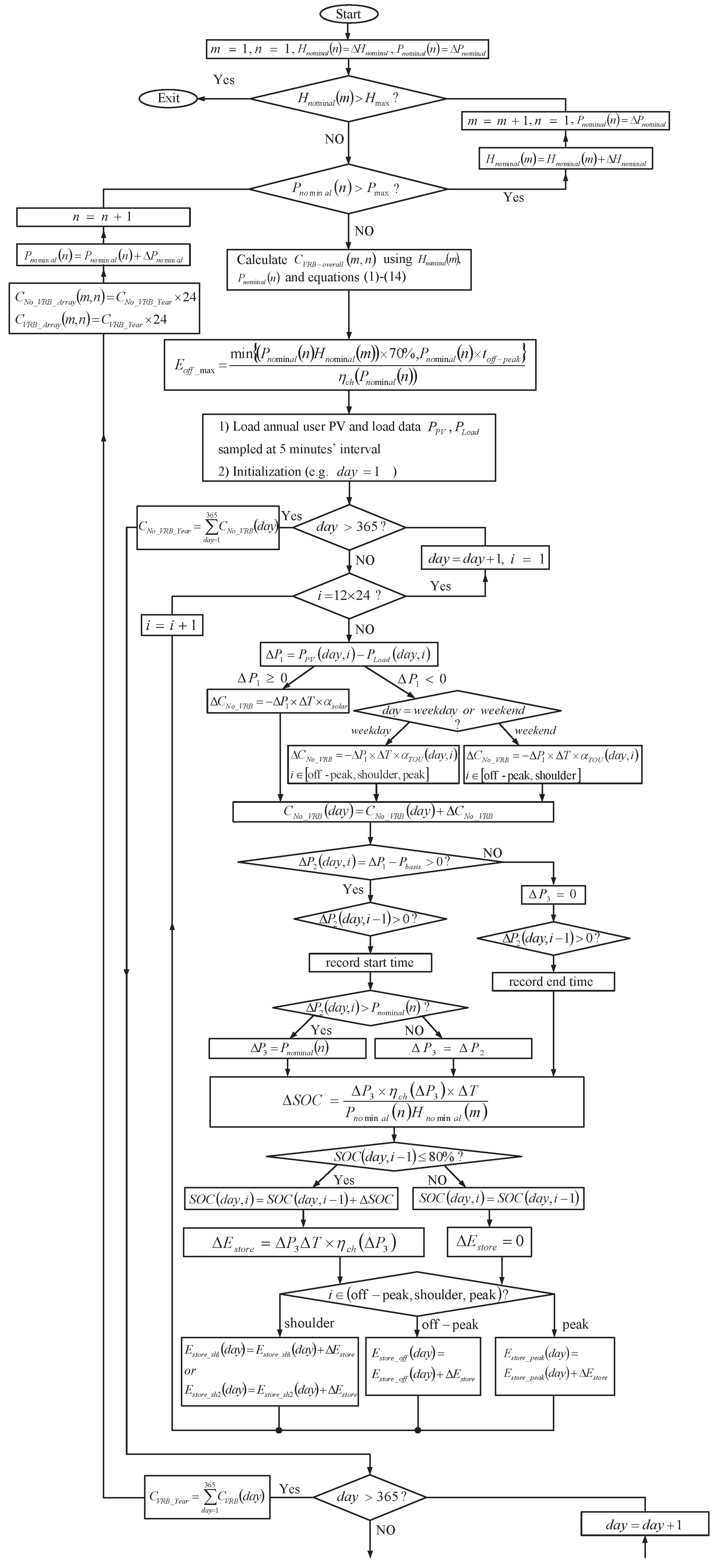
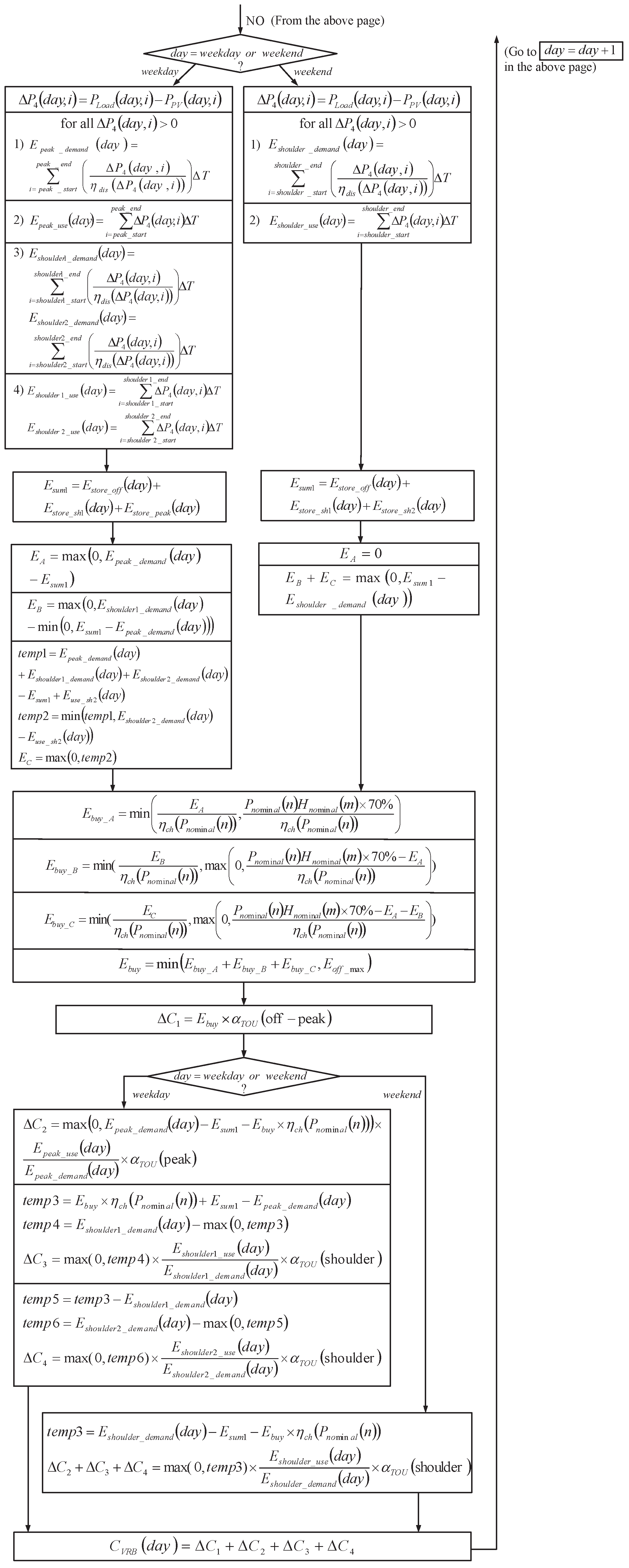
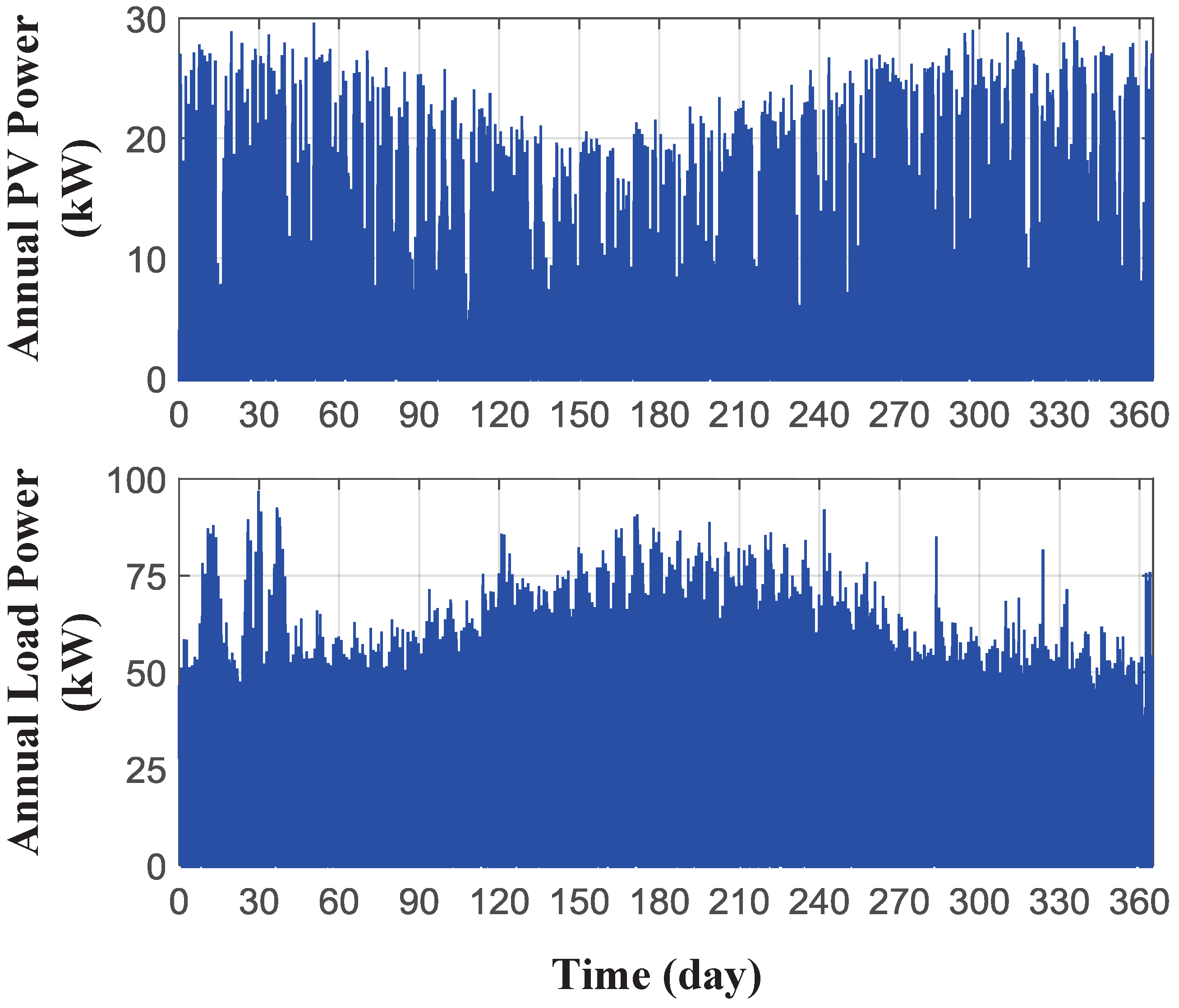

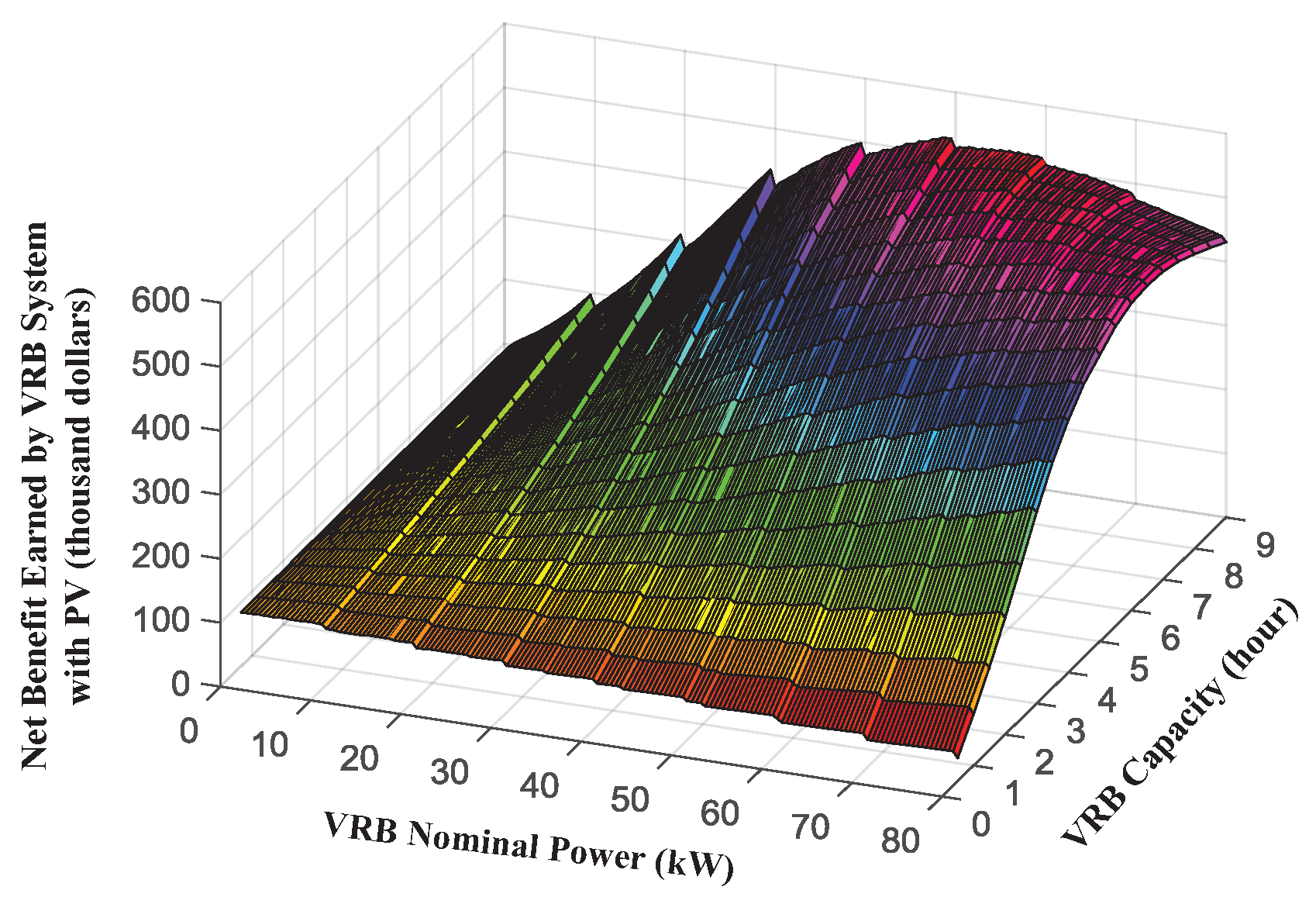

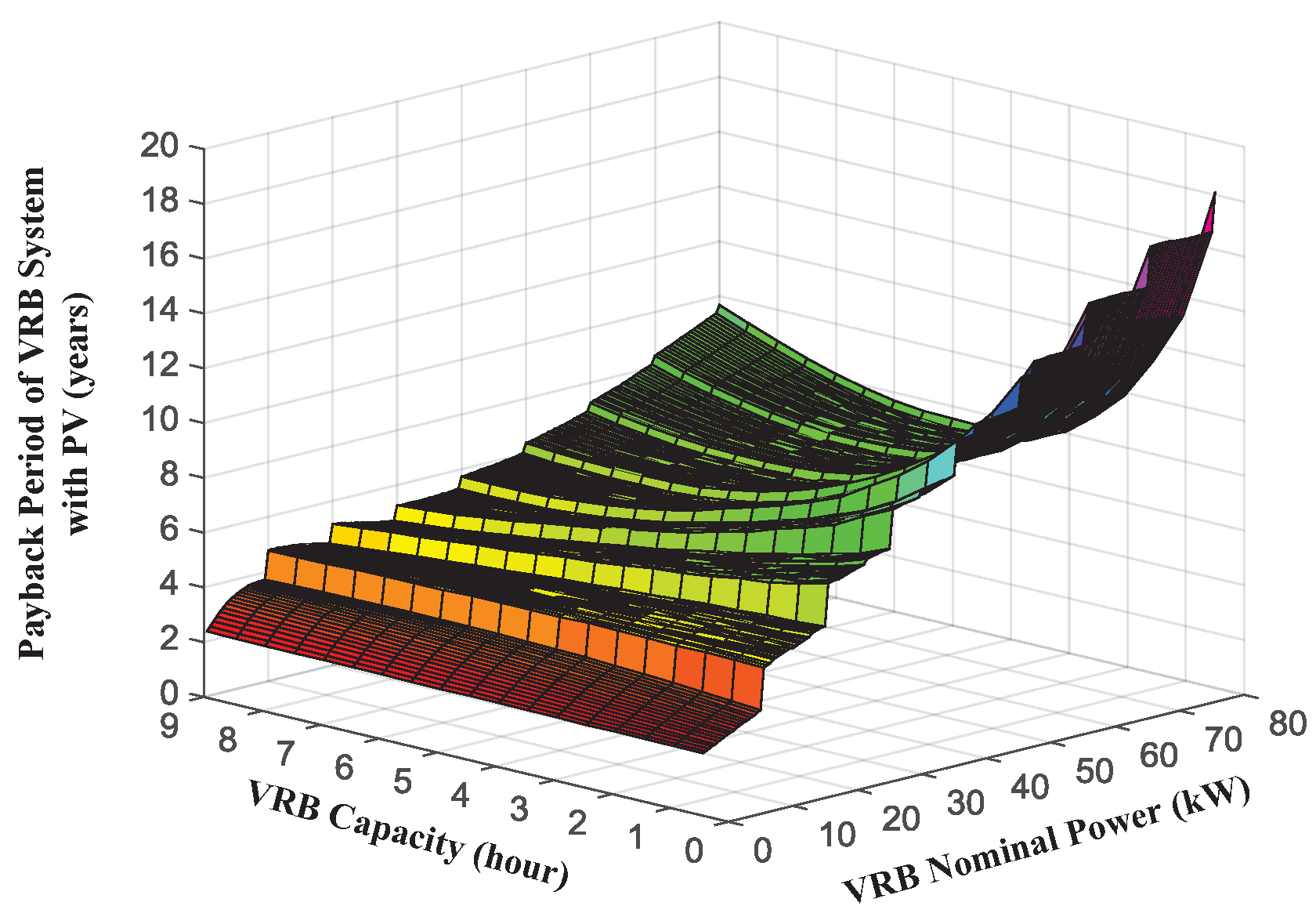
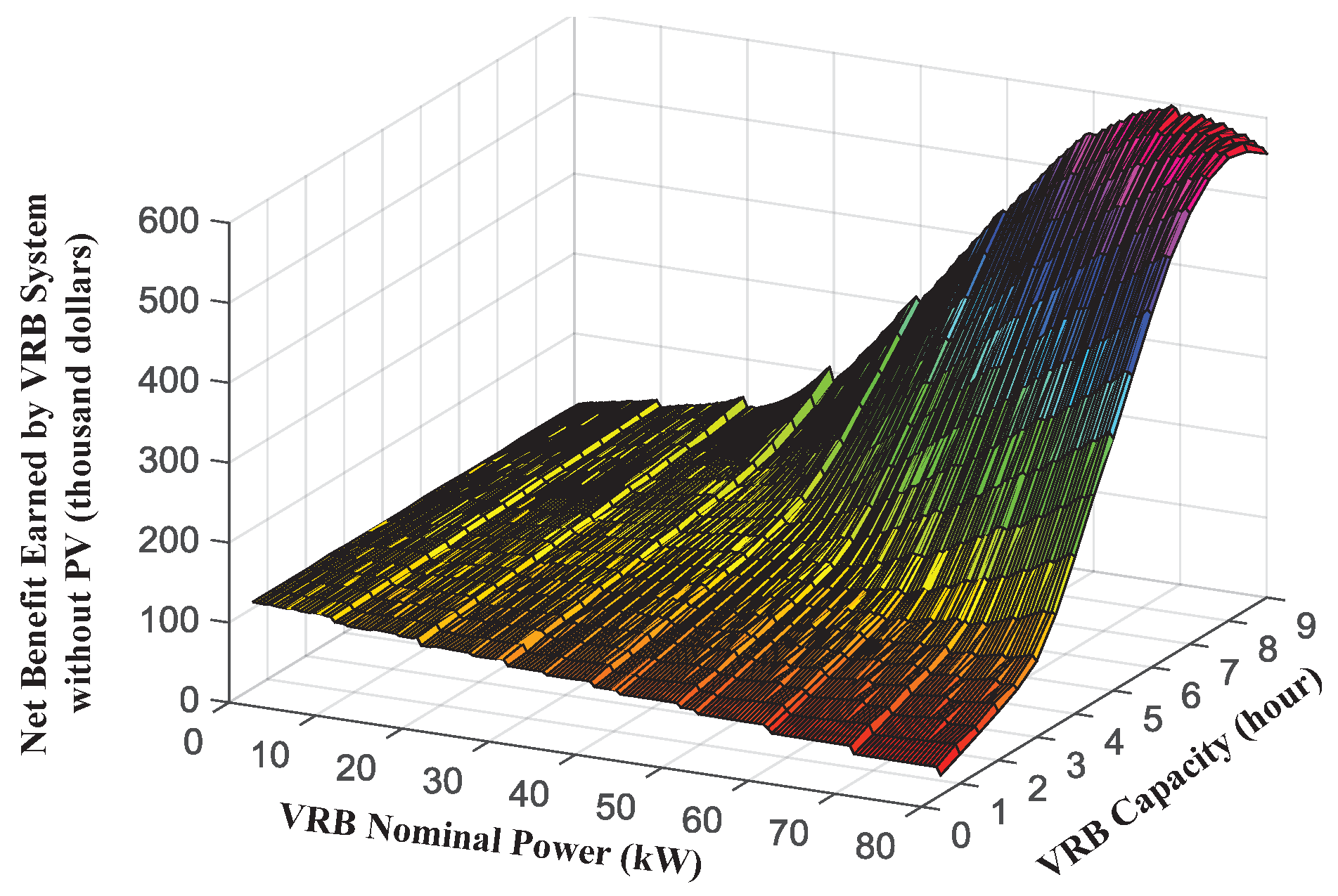
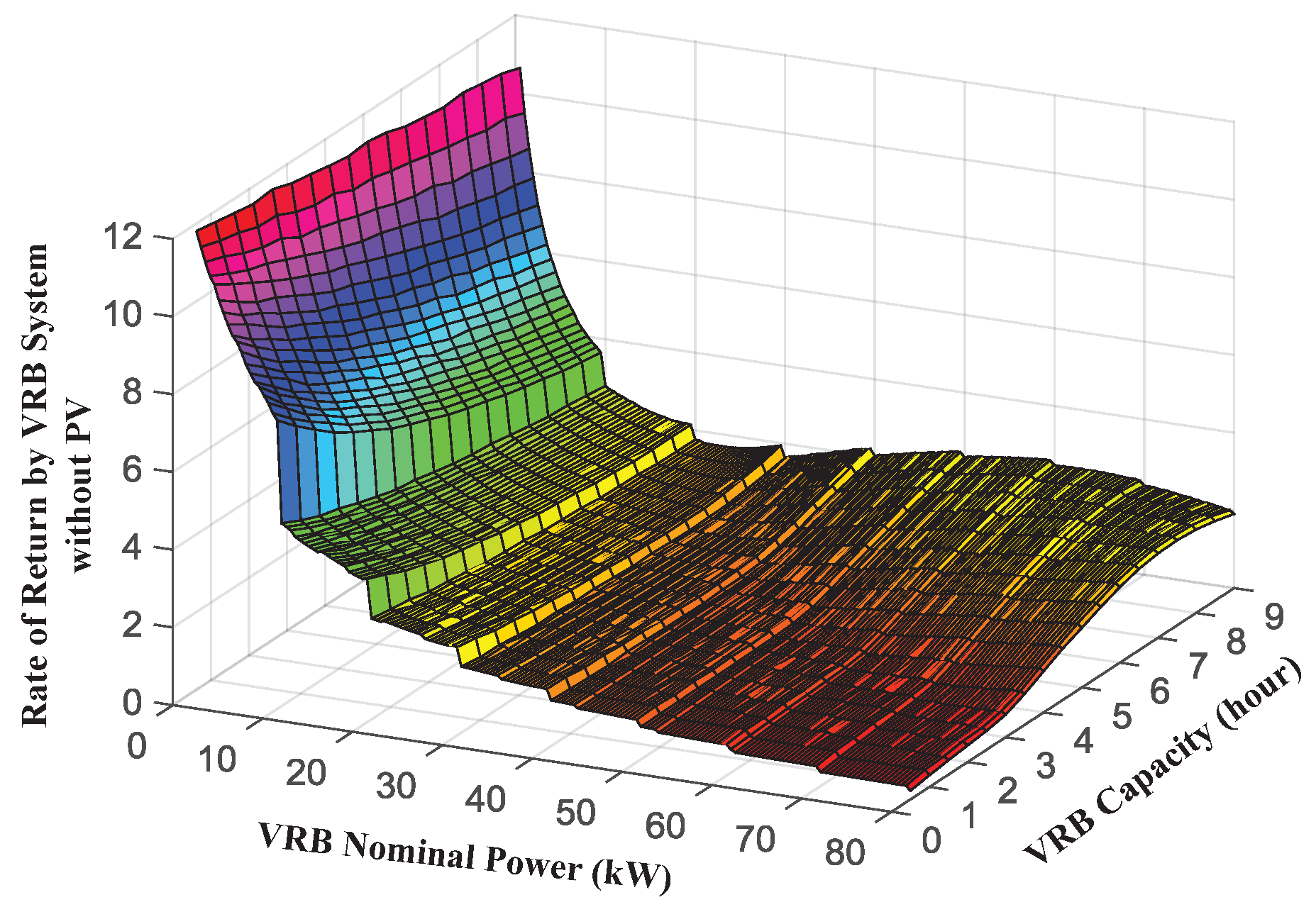
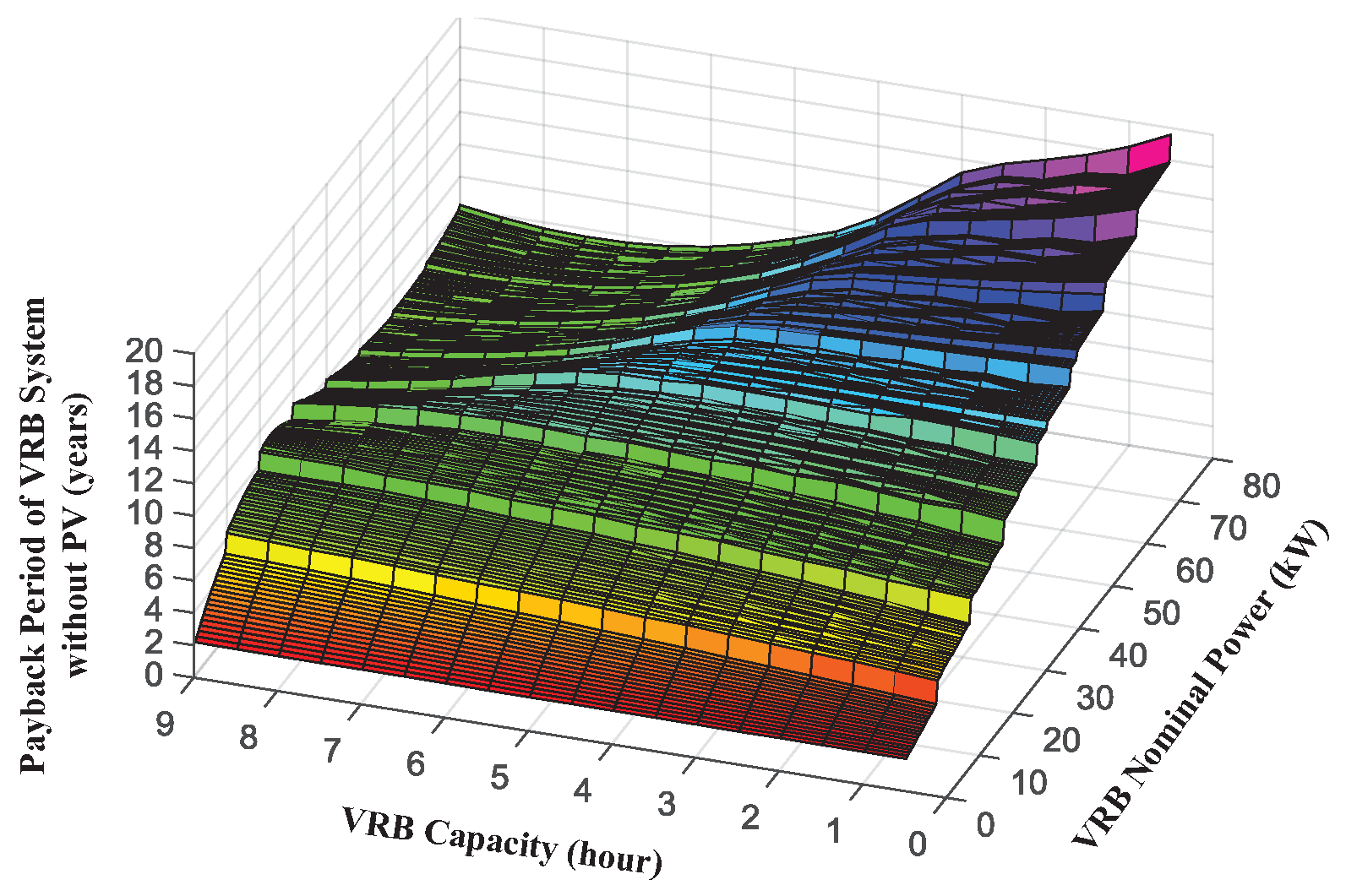
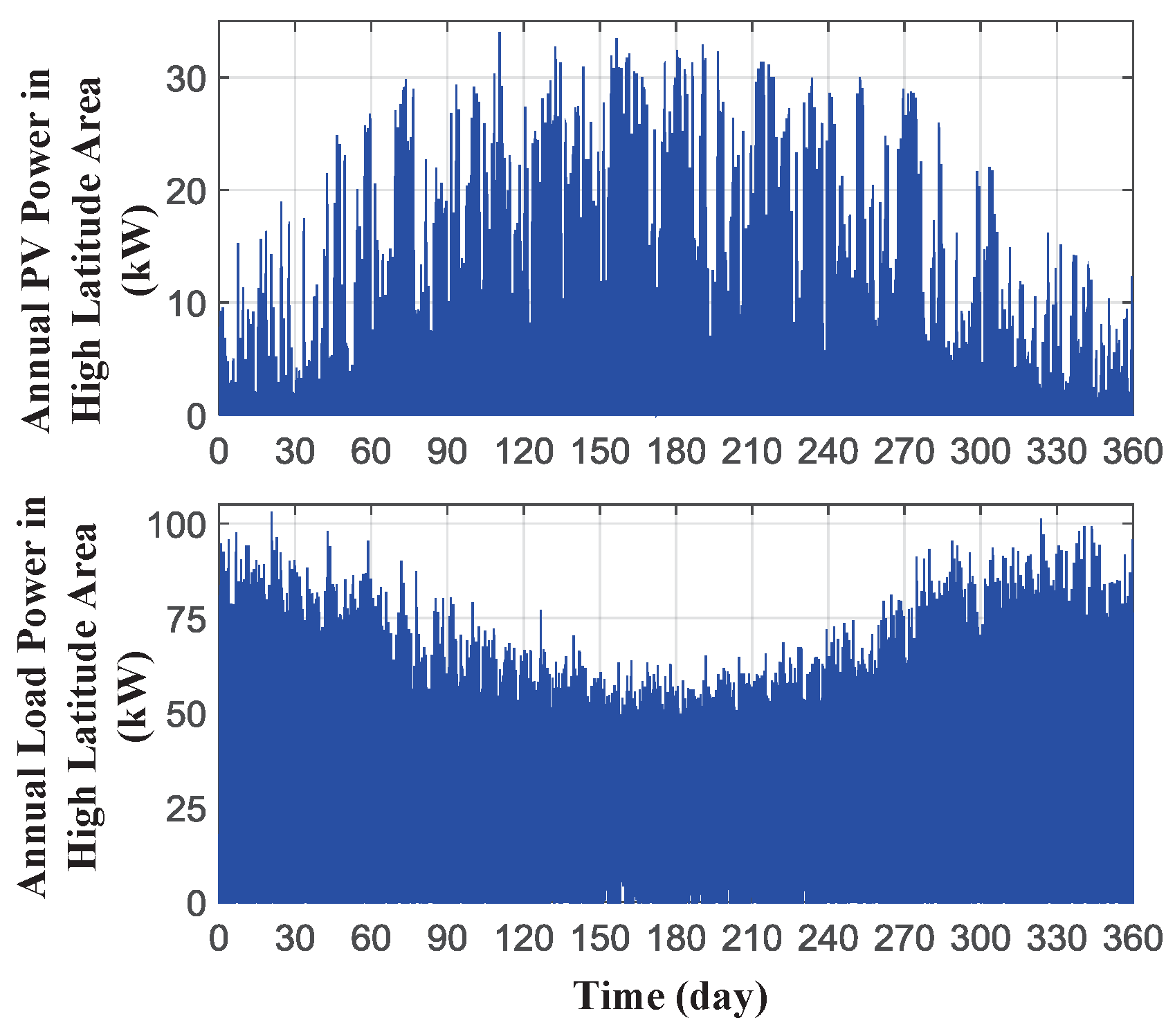
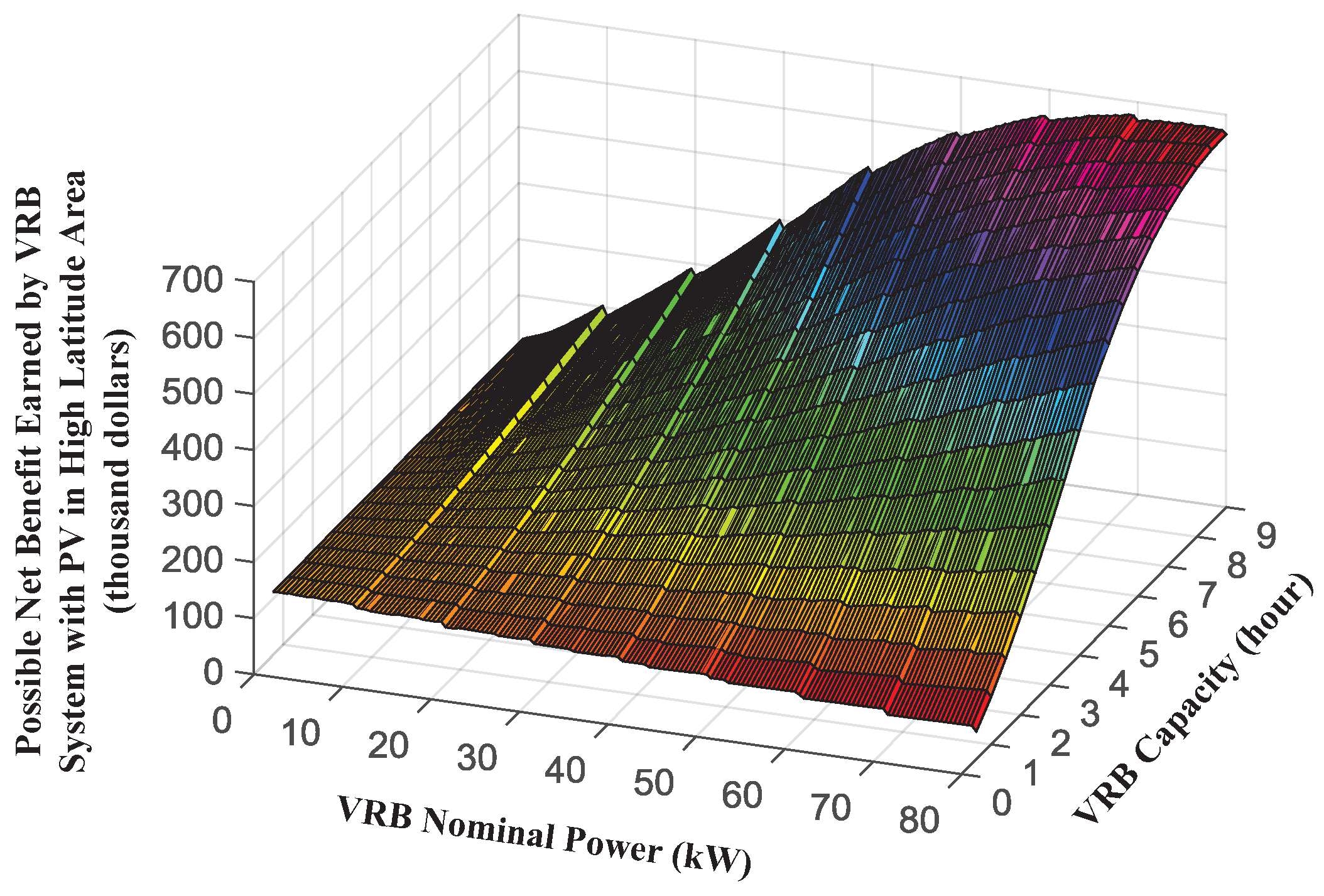
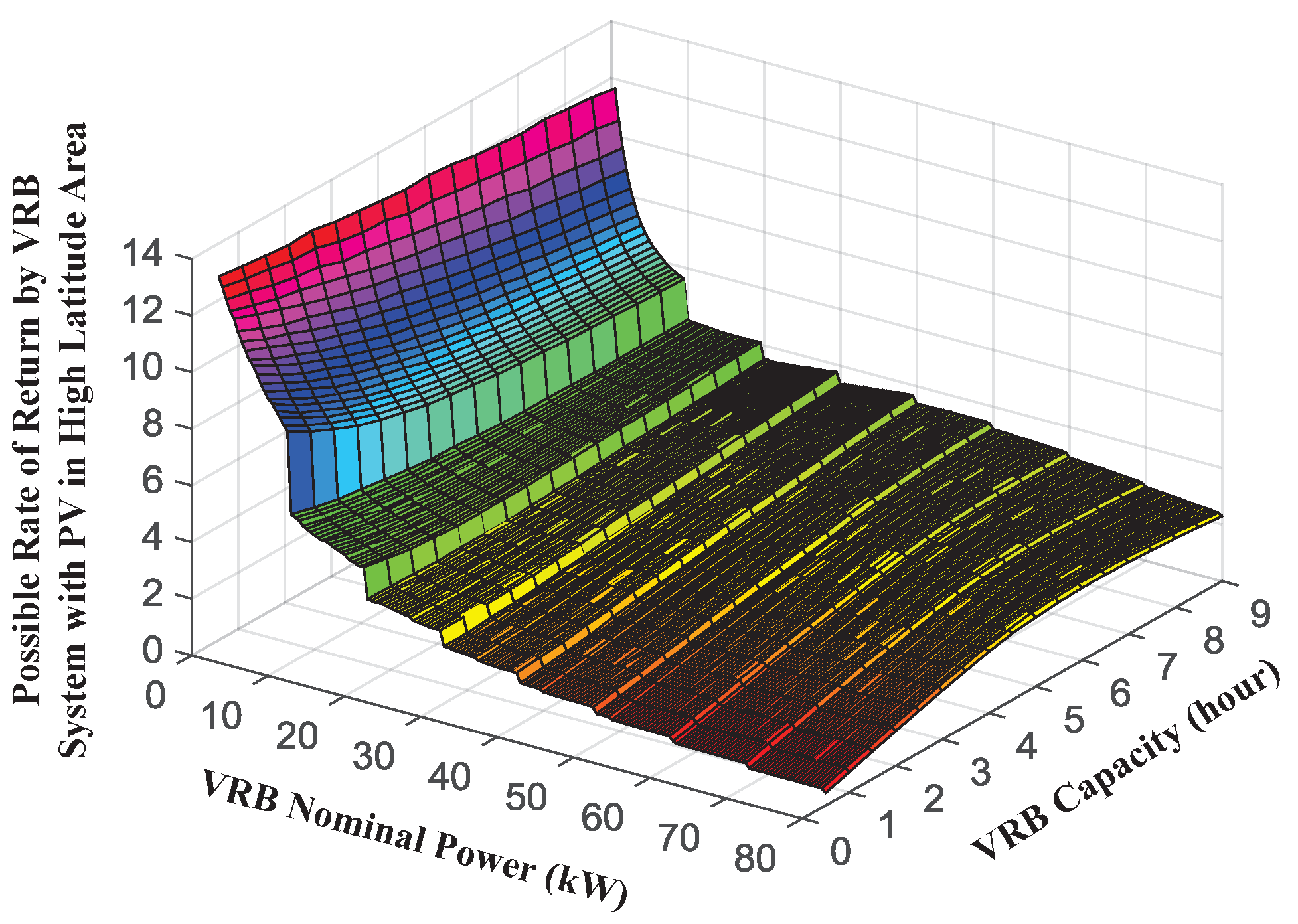
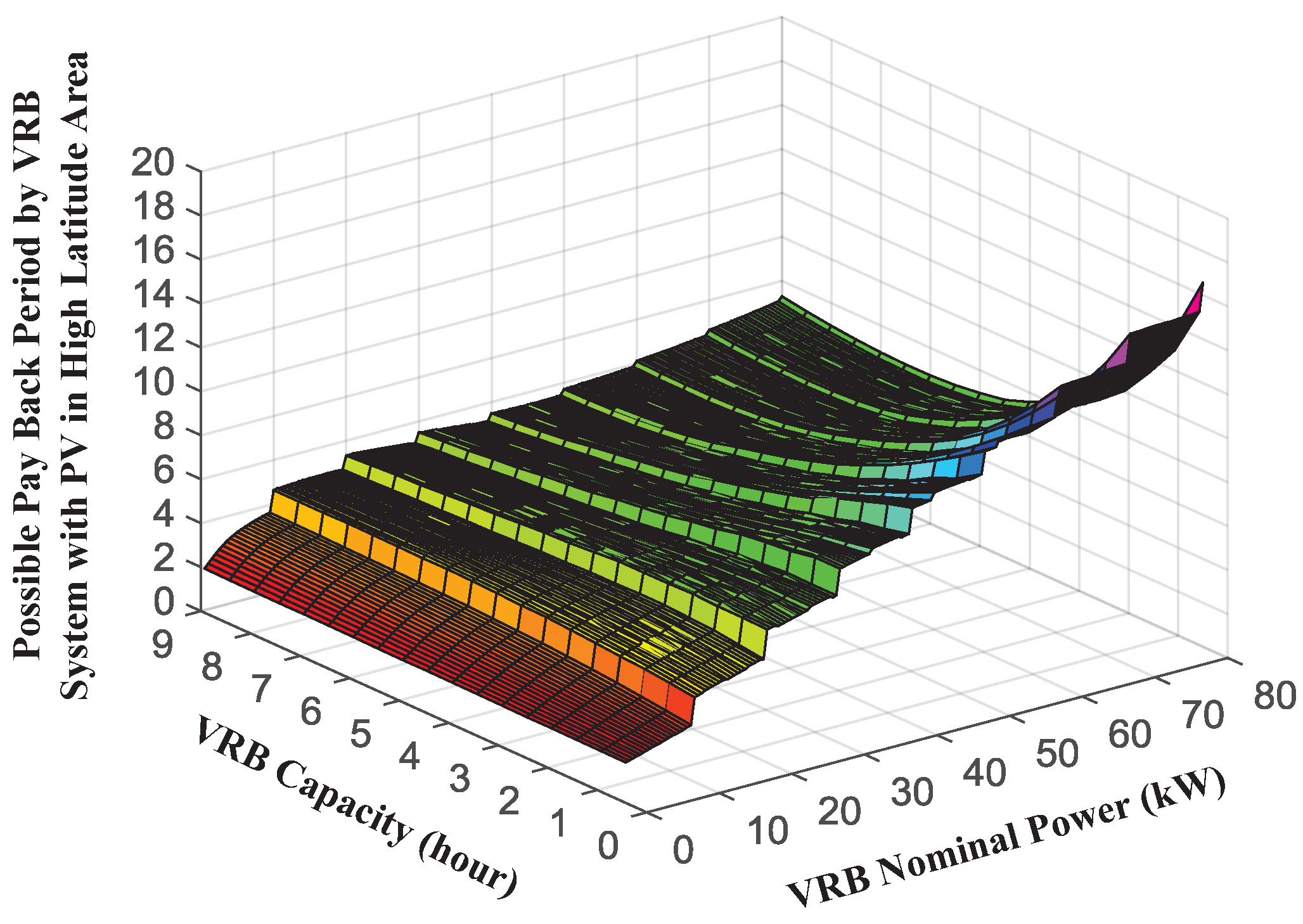
| Acronym | Meaning |
|---|---|
| PV | solar photovoltaic system |
| BESS | battery energy storage system |
| VRB | vanadium redox flow battery |
| TOU | time-of-use |
| SOC | battery state of charge |
| Parameter | Value | Parameter | Value |
|---|---|---|---|
| P_stack | 10 kW | v_stack | 48 V |
| R_cell | 1.5 Ohm·cm | v_efficiency | 0.82 |
| 5.22 kg/kWh | 57.4 mole/kWh | ||
| 70% | 1.6 mole/L | ||
| 50 dollar/m | 10 dollar/m | ||
| 500 dollar/each | 5 dollar/each | ||
| 2 dollar/each | 11 dollar/kg | ||
| 0.2 dollar/L | 25 dollar/kWh | ||
| 100 dollar/kW | 100 dollar/kW | ||
| 100 dollar/year | 500 dollar/stack | ||
| 10 dollar/kW | 1 | ||
| 8 years | 24 years |
| Notation | Definition |
|---|---|
| step increment of VRB nominal power in each iteration (kW) | |
| step increment of VRB nominal capacity in each iteration (hour) | |
| m, n | iteration index of VRB capacity, nominal power |
| iteration index of days in one year | |
| i | iteration index of sampling point in each day (data sampled every 5 min) |
| overall cost of VRB system including maintenance cost | |
| , | efficiency of VRB charge, discharge |
| time interval of off-peak region (s) | |
| The maximum amount of energy that can be bought in the off-peak region to charge VRB (kWh) | |
| generated power of the PV panel (kW) | |
| demanded load power (kW) | |
| to | temporary variables |
| increment of electricity cost for users without VRB | |
| daily electricity cost for users without VRB | |
| annual electricity cost for users without VRB | |
| array that stores the annual electricity cost for users without VRB under different nominal power and capacity combinations | |
| increment of energy stored in VRB | |
| energy stored in VRB during regions of peak, Shoulder 1, Shoulder 2 and off-peak | |
| the demanded energy storage in VRB to support load in peak, Shoulder 1 and Shoulder 2 regions in weekdays | |
| the demanded energy storage in VRB to support load in the shoulder region in weekends | |
| the actually used energy for load in peak, Shoulder 1 and Shoulder 2 regions in weekdays | |
| the actually used energy for load in the shoulder region in weekends | |
| to | temporary variables |
| PV and load data sampling interval (5 min) | |
| ,, | the amount of energy that is desired to be stored in VRB in the off-peak region to support load in peak, shoulder 1 and Shoulder 2 regions |
| ,, | the amount of energy that is actually bought and stored in VRB in off-peak region to support load in peak, Shoulder 1 and Shoulder2 regions |
| the total amount of energy that is actually bought in off-peak and stored in VRB | |
| increment of electricity cost in off-peak, peak, Shoulder 1 and Shoulder 2 regions | |
| daily electricity cost for users with VRB | |
| annual electricity cost for users with VRB | |
| array that stores the annual electricity cost for users with VRB under different nominal power and capacity combinations |
© 2016 by the authors; licensee MDPI, Basel, Switzerland. This article is an open access article distributed under the terms and conditions of the Creative Commons Attribution (CC-BY) license (http://creativecommons.org/licenses/by/4.0/).
Share and Cite
Zhang, X.; Li, Y.; Skyllas-Kazacos, M.; Bao, J. Optimal Sizing of Vanadium Redox Flow Battery Systems for Residential Applications Based on Battery Electrochemical Characteristics. Energies 2016, 9, 857. https://doi.org/10.3390/en9100857
Zhang X, Li Y, Skyllas-Kazacos M, Bao J. Optimal Sizing of Vanadium Redox Flow Battery Systems for Residential Applications Based on Battery Electrochemical Characteristics. Energies. 2016; 9(10):857. https://doi.org/10.3390/en9100857
Chicago/Turabian StyleZhang, Xinan, Yifeng Li, Maria Skyllas-Kazacos, and Jie Bao. 2016. "Optimal Sizing of Vanadium Redox Flow Battery Systems for Residential Applications Based on Battery Electrochemical Characteristics" Energies 9, no. 10: 857. https://doi.org/10.3390/en9100857
APA StyleZhang, X., Li, Y., Skyllas-Kazacos, M., & Bao, J. (2016). Optimal Sizing of Vanadium Redox Flow Battery Systems for Residential Applications Based on Battery Electrochemical Characteristics. Energies, 9(10), 857. https://doi.org/10.3390/en9100857






